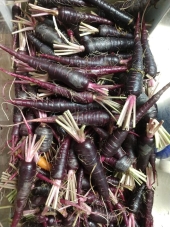
 9
9








 1
1




Idle dreamer
 4
4




Alex Arn wrote:My grandmother's farm in northern Missouri had quite a few of them. Does anyone know varietals that will work in zone 3b?
When you reach your lowest point, you are open to the greatest change.
-Avatar Aang




 3
3




I don't own the plants, they own me.
 1
1




 1
1




James Landreth wrote:
Alex Arn wrote:My grandmother's farm in northern Missouri had quite a few of them. Does anyone know varietals that will work in zone 3b?
If any would do it it would be Northrop (sometimes spelled Northrup). I believe it's good to zone 3. That's its rating but I would definitely protect it when young
https://www.treepeony.com/products/northrop-mulberry




 2
2




 4
4




 1
1




Alex Arn wrote:My grandmother's farm in northern Missouri had quite a few of them. Does anyone know varietals that will work in zone 3b?
 3
3




 1
1




Tim Kivi wrote:
I wish I could taste red mulberry (Morris rubra), but it’s an American native and they don’t sell it in Australia. I assume it won’t taste as good as black mulberry given that most people in the US have no interest in it.

 4
4




 5
5




 2
2




Ellendra Nauriel wrote:Mulberries are one of the three things that are tied for first place on my list of favorite fruits.
I have several of them growing wild on my property. They don't fruit every year, though, so I'll be adding some named cultivars eventually. I have noticed that the wild ones bear fruit depending more on stress than on the size of the tree. I've gotten berries off a tiny little sapling 2 feet tall, but that sapling only bore fruit the year after it survived a huge drought.
At one of my old jobs, there was an area behind the building that had run wild. The mulberries back there were covered in big, sweet berries every summer. I'd sometimes sneak in on the weekends just to pick them. When I'm ready to plant more trees, I'll probably grab a few cuttings from those, to see if it was the tree or the growing conditions that made them so productive.
 ) as well. I've got one tiny tree--only about 5' tall when it started bearing (it's about 15' now) and several others that are much larger that have never born fruit. They are everywhere around here on our property and in the national forest next door, but I only find a few that consistently bear fruit and they come in every size, shape and condition. I'm not sure what the factor is that promotes fruiting but I sure wish I did so I could get more of them to fruit!
) as well. I've got one tiny tree--only about 5' tall when it started bearing (it's about 15' now) and several others that are much larger that have never born fruit. They are everywhere around here on our property and in the national forest next door, but I only find a few that consistently bear fruit and they come in every size, shape and condition. I'm not sure what the factor is that promotes fruiting but I sure wish I did so I could get more of them to fruit!



Deb Stephens wrote:
I've noticed that mulberries are inconsistent fruiters (is that a word?) as well. I've got one tiny tree--only about 5' tall when it started bearing (it's about 15' now) and several others that are much larger that have never born fruit. They are everywhere around here on our property and in the national forest next door, but I only find a few that consistently bear fruit and they come in every size, shape and condition. I'm not sure what the factor is that promotes fruiting but I sure wish I did so I could get more of them to fruit!




Ellendra Nauriel wrote:
If stress is the key, then swatting the branches with something might help. It sounds ridiculous, and I haven't tried it myself, but a friend who runs an orchard swears by it. She uses a rolled-up newspaper, but I've found other accounts of people using baseball bats, or just random fallen branches they found.





Deb Stephens wrote:I beg to differ on this one Tim! Red mulberries are delicious--way better than blackberries in my opinion. They are sweet and juicy and like the black mulberry, they ripen over a long season so you can eat them fresh for a very long time.
 2
2




Living a life that requires no vacation.
 1
1




 1
1




Other people may reject you but if you lie in the forest floor for long enough the moss and fungi will accept you as one of their own!
 1
1




 1
1




Julie Inmon wrote: I did notice that the fruits were ALWAYS covered in tiny bugs like someone else mentioned. I want to say they were extremely tiny worms of some sort but my memory isn’t great. Does anyone know what they could’ve been and how to prevent/fix that? I’d love to have my own mulberry tree again one day.
-Julie
 Those are NOT worms but part of the berry. (My mother used to think the same thing and it made me not want to eat them when I was a kid. Another one of those old folk myths!) Mulberries are actually compound fruits (technically a multiple fruit is called a syncarp) where each little round ball (the technical term is drupelet) is a fruit all by itself although they cluster together to form what we call the berry. Those thread-like things coming off the individual fruits are just the styles leftover from the super tiny flowers. Mulberries form catkins with each individual flower composed of a calyx with 4 sepals. They don't actually have petals like most flowers. So that is what you are seeing--not bugs or worms, but flower parts. Enjoy them, they're delicious!
Those are NOT worms but part of the berry. (My mother used to think the same thing and it made me not want to eat them when I was a kid. Another one of those old folk myths!) Mulberries are actually compound fruits (technically a multiple fruit is called a syncarp) where each little round ball (the technical term is drupelet) is a fruit all by itself although they cluster together to form what we call the berry. Those thread-like things coming off the individual fruits are just the styles leftover from the super tiny flowers. Mulberries form catkins with each individual flower composed of a calyx with 4 sepals. They don't actually have petals like most flowers. So that is what you are seeing--not bugs or worms, but flower parts. Enjoy them, they're delicious!



 3
3




 1
1








Deb Stephens wrote:
Julie Inmon wrote: I did notice that the fruits were ALWAYS covered in tiny bugs like someone else mentioned. I want to say they were extremely tiny worms of some sort but my memory isn’t great. Does anyone know what they could’ve been and how to prevent/fix that? I’d love to have my own mulberry tree again one day.
-Julie
NO, NO, NO!!!Those are NOT worms but part of the berry. (My mother used to think the same thing and it made me not want to eat them when I was a kid. Another one of those old folk myths!) Mulberries are actually compound fruits (technically a multiple fruit is called a syncarp) where each little round ball (the technical term is drupelet) is a fruit all by itself although they cluster together to form what we call the berry. Those thread-like things coming off the individual fruits are just the styles leftover from the super tiny flowers. Mulberries form catkins with each individual flower composed of a calyx with 4 sepals. They don't actually have petals like most flowers. So that is what you are seeing--not bugs or worms, but flower parts. Enjoy them, they're delicious!

 1
1




List of Bryant RedHawk's Epic Soil Series Threads We love visitors, that's why we live in a secluded cabin deep in the woods. "Buzzard's Roost (Asnikiye Heca) Farm." Promoting permaculture to save our planet.








 1
1




Jerry Davis wrote: Male trees, allowing for their spring pollination of a couple weeks (depending on the weather), will eventually shade an area of about 50' around, making for great deep shade, but they will not get too tall by contrast with other large deciduous trees.
'What we do now echoes in eternity.' Marcus Aurelius
How Permies Works Dr. Redhawk's Epic Soil Series












 2
2




List of Bryant RedHawk's Epic Soil Series Threads We love visitors, that's why we live in a secluded cabin deep in the woods. "Buzzard's Roost (Asnikiye Heca) Farm." Promoting permaculture to save our planet.
 1
1




Weeds are just plants with enough surplus will to live to withstand normal levels of gardening!--Alexandra Petri
 1
1




Ben Schiavi wrote:Has anyone eaten cooked mulberry leaves? I have eaten the tiger paw shaped young leaves with no ill effects.
 2
2




Sometimes the answer is nothing











Megan Palmer wrote:
Ben Schiavi wrote:Has anyone eaten cooked mulberry leaves? I have eaten the tiger paw shaped young leaves with no ill effects.
I have not eaten them but have used the dried leaves and berries in TCM tonics. They are an ingredient in a sleep aid that I brew. They are also used in a number of other TCM brews http://www.shen-nong.com/eng/herbal/sangye.html
Other people may reject you but if you lie in the forest floor for long enough the moss and fungi will accept you as one of their own!




Come join me at www.peacockorchard.com
 1
1




 btw we ended up digging our kitchen grey water system to lead to near the roots of said Mulberries and they love it!
btw we ended up digging our kitchen grey water system to lead to near the roots of said Mulberries and they love it!




 3
3




Chasing that dream and enjoying every minute of it!
(Usually)

| I agree. Here's the link: http://stoves2.com |







